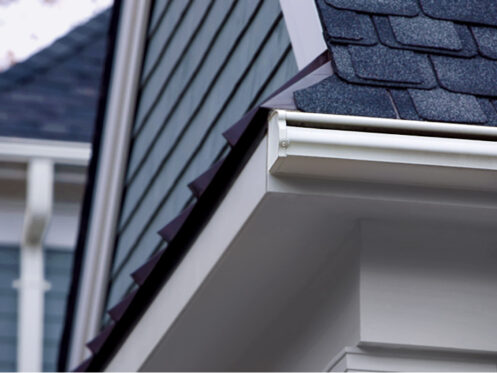If you’re unsatisfied with the way your shingles look or your roof has minor damage or leaks, a roof coating can be a great option. Roof coatings are designed for situations where a roof has some minor issues but is mostly still in good shape.
In this article, we’ll explain how roof coatings work and discuss the pros and cons of the most popular options.
What Is the Purpose of a Roof Coating?
A roof coating or sealant is primarily used to rejuvenate older asphalt shingles and overcome issues with damage or leaks. Most roof coatings create a completely watertight seal over the existing shingles and will fill in any gaps, cracks or damaged areas where water could seep underneath the shingles and potentially cause the roof to leak.
Most coatings are also UV-resistant, which helps to protect the shingles from weathering and deteriorating due to continual sun exposure. Some coatings will also prevent mold, mildew and moss from growing on the shingles, which also protects them from damage and the roof from leaking.
The coating will also help the granules on the shingles to adhere, which is important since the granules help to protect the shingles from UV damage. The problem is that the granules can easily get knocked off by hail or other impacts, which is something that a coating will help to prevent.
Having a coating put over your existing shingles is an easy way to extend the life of your roof so that you can hopefully put off any extensive repairs or have to replace it for years to come. Coating your roof is also much less expensive than a full replacement. If your shingles are faded, a coating can help to restore them to close to the original color to improve your home’s curb appeal as well.
While a roof coating can be a great alternative to replacing your roof, it really depends on the overall condition of the roof. A coating is a good option if your roof is generally still in good shape and you’re just looking to overcome issues with faded shingles or minor damage/leaks. If the shingles are fairly old and have deteriorated a lot or the roof has more extensive damage or major leaks, coating the roof won’t make much of a difference. As such, it’s important to have a professional roofing contractor perform a full inspection to determine whether a roof coating will help or if you need to just have your roof replaced.
Silicone Roof Coating
Silicone is usually considered to be the best and most effective coating for asphalt shingles, but it is also usually the most expensive option. Silicone is a synthetic, solvent-based sealant that typically outperforms most of the other options both in terms of overall protection and lifespan. Some roof coatings need to be reapplied every few years, but silicone coatings usually continue performing well for around 10 years. A silicone coating will make the shingles waterproof to help protect against leaks and damage from moisture. This type of coating is also highly UV resistant and provides excellent protection against sun damage.
The biggest drawback to silicone is that it doesn’t adhere or bond quite as well as some of the other options. To overcome this, the roofers will usually first need to pressure wash the entire roof to ensure that the shingles are as clean as possible. They will also then need to wait for the shingles to completely dry out since the coating still won’t adhere if there is any moisture on the roof.
Acrylic Roof Coating
Another good option is an acrylic roof coating. This type of coating typically has the longest lifespan and should last for well over 10 years. An acrylic coating also tends to offer the best protection against sun damage. Acrylic coatings are either water-based or solvent-based. Although water-based acrylic is easier to apply and doesn’t give off harmful VOCs like solvent-based acrylic does, a solvent-based acrylic coating will usually last longer and perform better.
The main issue with acrylic coatings is that they aren’t nearly as waterproof as most of the other options. An acrylic coating will work quite well in drier climates but usually isn’t recommended for areas that get lots more rain and/or snow.
Polyurethane Roof Coating
A solvent-based polyurethane coating typically offers the best protection against water and moisture since it is extremely waterproof. This is why it’s one of the most preferred options for areas that usually receive lots of rain and snow. Polyurethane has a very high tensile strength, which helps to make the shingles more resistant to hail, wind and storm damage. The biggest drawback is that the coating is less UV resistant and doesn’t offer nearly the same level of protection against sun damage compared to acrylic or silicone coatings.
There are two different types of polyurethane coatings: aromatic and aliphatic. Aromatic polyurethane typically costs about half as much as aliphatic, but the installation price is often fairly similar. This is because aliphatic polyurethane is much thicker so less of it is required to cover an entire roof. The main issue with aromatic polyurethane is that it is much thinner and doesn’t provide nearly the same amount of UV protection compared to aliphatic polyurethane. Aromatic polyurethane can make a good base coat, but you will almost always need some type of additional top coat or else the shingles will still discolor and deteriorate much more quickly.
Liquid Rubber Roof Coating
A liquid rubber roof coating is usually the best option if you’re on a more limited budget since it tends to cost quite a bit less than the other options. It is also considered more eco-friendly compared to other types of roof coatings. A liquid rubber coating offers quite good protection against storm damage and weather. It is also fireproof and waterproof and has a solar reflective finish that helps to protect against sun damage. The main drawback to rubber coatings is that they usually don’t last as long as other options like acrylic and silicone. On the other hand, liquid rubber bonds extremely well to most surfaces so less prep work may be required before applying the coating.
One thing to note is that most other roof coatings are clear when they dry and have a slightly glossy finish that helps to rejuvenate the look of old, faded shingles. Liquid rubber coatings instead are colored. Although many color options are available, it may sometimes be difficult to find one that perfectly matches the existing color of your shingles.
San Antonio’s Family-Owned Roofing Team
BELDON Roofing Company is a family-owned company. We have served residential and commercial customers in the San Antonio area since 1946. We specialize in all roofing services and are ready to help if you want to have your roof coated or if it needs to be repaired or replaced.
If you’re considering coating your roof, our experienced team can perform an inspection and determine whether a coating will overcome your specific issues. We can also help you determine which type of coating will work best for your specific needs and fit in your budget.
For more information on your roof coating options or to schedule any roofing inspection, gutter, window or siding services, contact us today.

